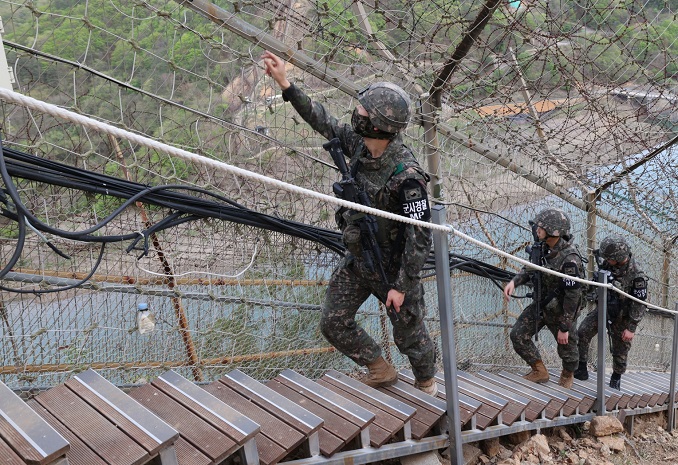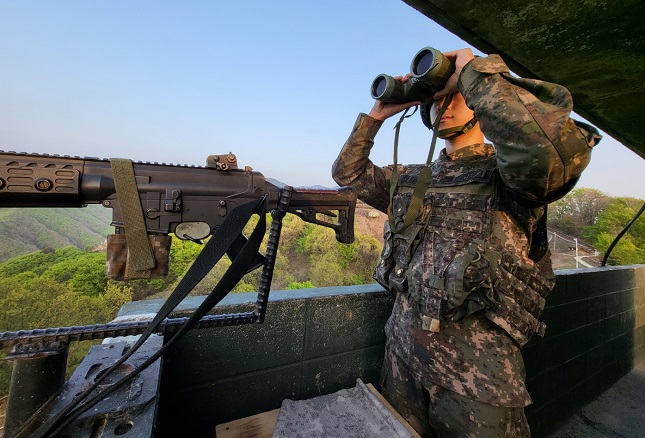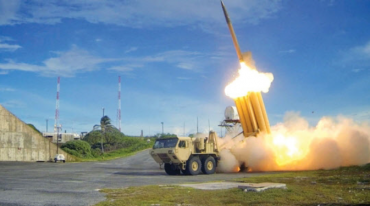
In this undated file photo provided by the Army, 7th Infantry Division troops patrol along barbed wire fences in the border county of Hwacheon, 89 kilometers northeast of Seoul.
HWACHEON, April 30 (Korea Bizwire) — Less than a decade ago, ground troops used to monitor the heavily-fortified border primarily by eye and with binoculars, and through other tried-and-true methods requiring their around-the-clock presence.
But their onerous workload has eased, as the military has introduced cutting-edge equipment, such as high-resolution cameras and sensor systems, to ward off potential border breaches at a time of tensions heightened by a provocative North Korea.
Such technology-based defense operations were on full display Thursday when the defense ministry’s press corps was invited to a battalion of the 7th Infantry Division tucked in the mountainous terrain in Hwacheon, 89 kilometers northeast of Seoul.
The battalion, nicknamed “North Star,” is in charge of defending the central and eastern front lines lined with barbed wire fences along the Demilitarized Zone (DMZ) — a 4-kilometer-wide strip that has separated the two Koreas since the end of the 1950-53 Korean War.
There appeared to be no worrisome signs of North Korean activities during the press tour, but the troops remained on high alert due apparently to tensions caused by Pyongyang’s recent weapons tests and its menacing rhetoric.
As troops patrolled along the barbed wire fences, others inside the battalion’s indoor observation posts pored over surveillance screens, including those that utilize thermal observation devices, locked on targets north of the border, notably North Korean guard posts.
A single surveillance soldier is in charge of multiple cameras in operation around the clock — so as to ease border troops’ burden of monitoring enemy movements by eye.
“While outpost troops are watching North Korea, other blind spots are taken care of by our troops using surveillance systems,” Lt. Col. Park Se-young told reporters.

A 7th Infantry Division soldier stands guard at an outpost in the border county of Hwacheon, 89 kilometers northeast of Seoul, in this undated file photo provided by the Army.
Draped across the barbed wire fences were wired sensors programmed to trigger an instantaneous alert if they are compromised.
When the sensors are twisted or bent with just enough force, the battalion command center is immediately alerted, with surveillance cameras automatically shifting their viewing angle onto the area in question.
The unit’s division rolled out advanced technologies in 2015 in earnest to make border protection more efficient and secure.
While technology has eased some of the troops’ physical burden, it still requires constant maintenance to function properly.
Troops make weekly inspections on all of the wire sensors on top of daily spontaneous checks. In case of malfunctions, maintenance troops are on standby round-the-clock.
State-of-the-art technology has also yet to resolve problems arising from poor weather conditions.
During heavy snow, troops are left with shovels and brooms to remove piles of snow from the patrol paths.
Still, troops at the perilous border remain in high spirits despite being stationed in the isolated unit.
“While I sometimes feel burdened by the fact that I am the first one to observe the enemy on the front line, it feels worthwhile to fight off sleep at night, knowing that I am protecting my family, friends and fellow soldiers,” Cpl. Lee Jun-min said.
(Yonhap)






